PERIDOT
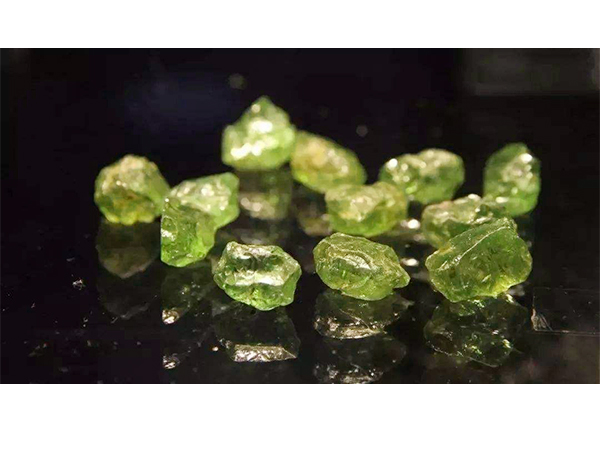
The main components are iron, magnesium, silicon, and may contain elements such as manganese, nickel, and cobalt. The crystals are granular and are dispersed or granular aggregates in the rock.
It belongs to island silicate. Olivine can be altered to form serpentine or magnesite, which can be used as a refractory material.
Gem-grade olivine is mainly divided into rich yellow-green olivine, golden green olivine, yellow-green olivine, rich green olivine (also known as dusk emerald or western emerald, evening primrose emerald) and celestial gems (produced in It is very rare in the meteorite.)
The high-quality olivine is transparent olive green, emerald green or yellow-green. The clear and beautiful color is very pleasing to the eye, symbolizing the good wishes of peace, happiness and peace. In the war between some ancient tribes, peace was often expressed by the exchange of olivine. In some temples in Jerusalem, there are still olivines inlaid thousands of years ago.
Introduction
Peridot is a magnesium and iron silicate with a chemical formula of (MgFe)2SiO4, one of the most common minerals on earth, also found in some meteorites, moons, Mars and some comets (eg Wilt II) Part of the dust on the comet and the nucleus of the Temple I comet.
Olivine is named for its olive green color. Its English name is Peridot or Olivine, the former is directly from French Peridot, the latter is a mineralogy. Peridot was discovered about 3,500 years ago on St. John's Island in the ancient Egyptian territory. Gem-quality olivine is divided into rich yellow-green olivine, golden green olivine, yellow-green olivine, rich green olivine (also known as dusk emerald or western emerald, evening primrose emerald) and celestial gems (produced in vermiculite) Medium, very rare).
The high-quality olivine is transparent olive green, and the clear and beautiful color is very pleasing to the eye, symbolizing the good wishes of peace, happiness and peace. In the war between some ancient tribes, peace was often expressed by the exchange of olivine. In some temples in Jerusalem, there are still olivines inlaid thousands of years ago.
Olivine has been discovered in outer space, and other types of gems have not yet been discovered.
chemical components
The composition of olivine is mainly a complete homogeneous homomorphic crystal formed by the two end components of Mg2SiO4 and Fe2SiO4. In the iron-rich members, a small amount of Ca2+ and Mn2+ may be substituted for Fe2+, and a magnesium-rich member may have a small amount of Cr3+ and Ni2+ to replace the Mg2+ therein, and may further contain a trace amount of Fe3+, Zn2+, and the like.
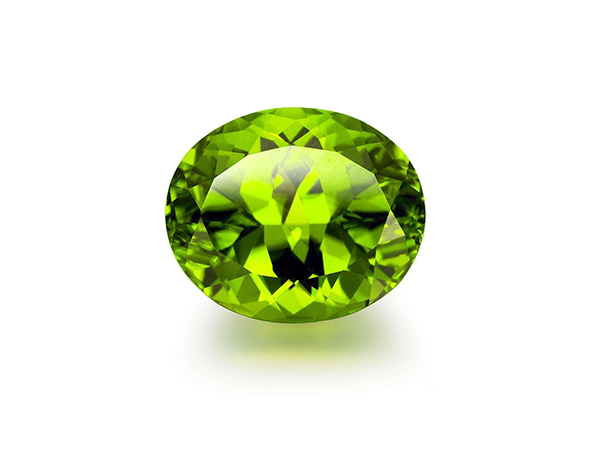
Optical properties
The biaxial crystal is positive, and the excess iron is negative. The refractive index is generally between 1.654 and 1.690. The birefringence is 0.035-0.038, and the faceted stone can be seen from the countertop with double-shadowed facets and double-faced inclusions. Dispersion (0.020) is medium.
Under ultraviolet light, olivine has no fluorescence reaction. The color under the Charles filter is green. The characteristic absorption spectrum is 433 nm, 474 nm in the blue region, and three absorption narrow bands at 497 nm.
Mechanical properties
100, 0101 two groups of cleavage is not complete, shell-like fracture. Hardness 6.5-8, moderate toughness. Density: gem grade is 3.34 g/cm3. It has high heat sensitivity and is easily broken when it is heated unevenly or rapidly.
Quickly react with HCI, HF or concentrated, hot H2SO4; do not wash with any acid or alkali solution.
Microscopic characteristics: mineral inclusions are common in olivine. These solid inclusions are often accompanied by disc-shaped stress streaks or gas-liquid inclusions, which are called “lily lotus leaf”-like inclusions, in addition to red. Brown black mica, chrome diopside, graphite, calcite, etc., can also be seen zircon halo, negative crystal, cloud-like inclusions.
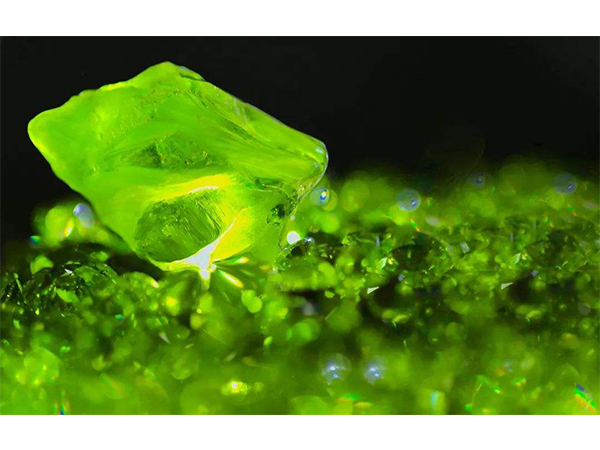
1. Crystal system and crystal habit.
Orthorhombic system: The crystal is mostly short column or thick plate. Common single shapes have parallel sides.
Oblique square and beveled double cone. Gem-grade olivines are often irregular in shape and are rare.
2. Color and pleochroism, mainly yellow-green, a small amount of brownish green or brown. Polychromaticity is weak.
3. Gloss and transparency: glass luster, transparent to translucent.
4. Photonicity: Biaxial crystal, the positive and negative of light depends on the composition.
5. Refractive index and bijectivity: RI: 1.65-1.69, RI: 0.036, slightly higher brown varieties.
6. Dispersion: 0.020, medium.
7. Absorption spectrum: three absorption bands in the blue region are 453 nm, 473 nm, and 493 nm.
8. Hardness: 6.5-8 [1], which varies with composition.
9. Relative density: 3.32-3.37, which varies with composition.
10. Cleavage and fracture: poor cleavage, shell-like fracture.
11. Inclusions
Inclusions - Common mineral inclusions in olivine, often surrounded by disc-shaped stress streaks or gas-liquid inclusions.
12. Cut: High quality, visible fire.
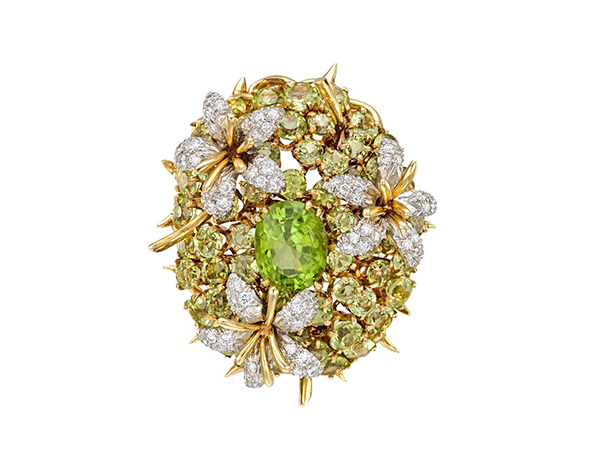
The world-famous producers of high-quality olivine are China's Jilin Dunhua Yisong Pine Forest and Myanmar's Mogok area, Brazil, the Red Sea, Egypt's St. John's Island, Italy's Vesuvius, Snar of Norway, and the Eifel region of Germany. Arizona, New Mexico, etc. in the United States. China's Jilin Dunhua and China's Hebei Zhangjiakou, Shanxi Tianzhen, have found gem-quality olivine.
Olivine is a major component of mantle rocks and is widely produced in metamorphic rocks of various basic, ultrabasic and magmatic carbonates.
Most of the world's olivine is produced in deep-source inclusions of alkaline basalt and spinel olivine peridotite. The olivine produced in Hebei and Jilin in China belongs to this form. A small amount of olivine is veined in the peridotite.
China's Jilin Dunhua Yisong Pine Forest, Brazil, Australia, Norway, Pakistan, Egypt, Sebt Red Island is a famous producer of high quality olivine. Other well-known origins are in Australia, Brazil, Kenya, Tanzania, Norway, Sri Lanka and Myanmar; Myanmar has also been a famous olivine-producing country and has produced some large-grained olivine. The former Soviet Union and the Czech Republic also produce some olivine.
The original stone is produced in the serpentine petrified peridotite nickel vein. High-quality giant peridot gemstones near Mogok, Myanmar. The olivine deposit on the northern border of Mexico is one of the world's largest olivine deposits, with olivine brown.
China's Jilin Dunhua Yisong Songlin District, China's Hebei Wanquan County, the Damaping olivine is green to yellow green. Zebargad, an ancient and famous place of origin in Egypt, has produced little, but the olivine is large in size and still has a few centimeters of gemstones.
The olivine of San Carlos, Arizona, is the largest source of gem-quality olivine; the olivine with traces of chrome and color is produced on the coast of Hawaii; the ancient famous place of origin, Zebargad, has not produced much, but the olivine is large in size. A few centimeters of large gemstones are produced.
Two well-known olivine origins in China are basalt inclusions. The yield of the Songhua Yisong Songlin District in Jilin Province is much larger than that in the Zhangjiakou area of Hebei Province. The diameter of the olivine in the Dajiaping of Zhangjiakou is generally 5-7 mm, showing olive green and yellow-green.
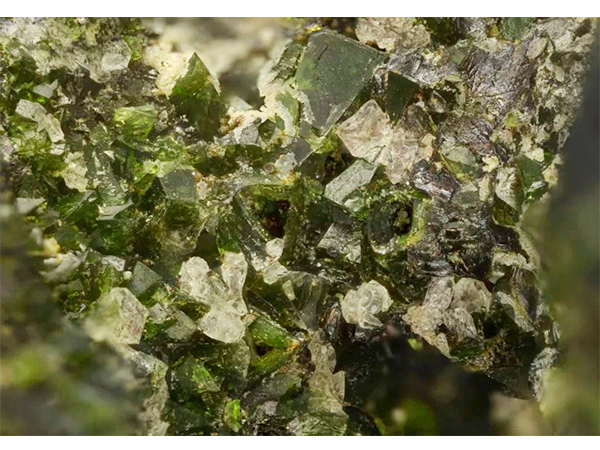
Its main chemical formula is R2SiO4, and the crystal is a general term for a group of island-like structure silicate minerals of orthogonal (orthortic) crystal system. Often olive green, hence the name olivine. In the chemical formula, R is mainly divalent cation magnesium, iron
,manganese. Due to the substitution of the isomorphism between them, Mg2SiO4-Fe2SiO4 (forsterite-fayalite), Fe2SiO4-Mn2SiO4 (fayalite-manganese olivine), Mn2SiO4-Mg2SiO4 (manganese olivine-magnesia) can be formed. ) and other series. Members of the forsterite-ferrite series are common.
The intermediate member of the series (Mg, Fe)2 [SiO4], commonly referred to as olivine, is the most common in nature. The crystals are short columnar and often form a granular aggregate. Magnesium-rich color, often with a yellow hue, iron-rich color, glass luster, broken grease luster. The Mohs hardness is 6.5-8, and the specific gravity increases with the increase of iron content, which is 3.3-4.4. Olivine is the main mineral that makes up the mantle and is the main mineral component of meteorites and moonstones.
It is commonly found in basic and ultrabasic igneous rocks as the main rock-forming mineral. Forsterite is also produced in magnesium skarn. The olivine is altered by a hydrothermal fluid to become serpentine or olive jade. Transparent, brightly colored, flawless olivine crystals can be used as gemstones. The ancient Egyptians used olivines in BC. The ancient church in Cologne, Germany, is inlaid with high quality peridot gemstones.
Mineral characteristics
The olive salt is an island-like structure of citrate mineral with a chemical formula of (Mg, Fe)2 [SiO4], usually composed of a mixture of Forsterite Mg2SiO4 and Fayalite Fe2SiO4. It is an orthorhombic system. The crystal form is often short columnar, and the aggregates are mostly irregular. The color of the pure forsterite is colorless to yellow; the pure iron olivine is greenish yellow; when oxidized, it turns brown or brown. Mostly olive green, yellow green, golden green or grandmother green. Grease is shiny and transparent.
The refractive index is 1.654-1.690 and the birefringence is 0.035-0.038, so under the magnifying glass, the bottom of the cut olivine will have a double shadow surface. The pleochroism is not obvious and the dispersion is 0.020.
Hardness 6.5-8.0, specific gravity 3.27-3.48. It has a shell-like fracture, which has poor toughness and is prone to cracks. The mineral most similar to olivine is Sinhalite, an orthorhombic brown-yellow or green-brown mineral with the composition Mgaibo4. Its specific gravity is 3.47 to 3.49, and the low, medium and high values of refractive index are 1.668, 1.699 and 1.707, respectively. The world-famous British Museum once mistakenly recognized a borosilicate as an olivine. This gem is produced in Sri Lanka and Myanmar.

Mineral occurrence
Olivine is a fairly common rock-forming mineral and one of the earliest minerals formed during magma crystallization.
It is more common in dark-colored or ultra-basic igneous rocks such as gabbro, basalt and peridotite. mineral.
Symbiotic minerals are calcium plagioclase and pyroxene.
best in the world
The world's largest gem-quality peridot is produced in the Red Sea island of Zabajad, weighing 319 carats, and is now in the Smithsonian Institution Museum in Washington, USA. The olivine found in Da Ma Ping, Wanquan County, Zhangjiakou, Hebei Province, China, weighing 236.5 carats, is named "North China Star" and is the largest olivine in China. Also in the Geological Museum in London is a 146-carat square emerald cut dark green olivine from Zeberget.
effect
Physiological action
Heart-shaped gemstones, the glands affected by the heart wheel are the heart, lungs, immune system, thymus, lymph glands. It is said that green or pink light can be used to treat heartache, heart disease, high blood pressure, difficulty breathing, nervousness, insomnia, anger, delusion, Cancer, especially cancer treatment, is best done in green.
Psychological function
Peridot is also known as the “jewel of the sun”. It is believed that the olivine has the same strength as the sun, which can remove people's fear of the night and give the wearer a gentle temperament, good hearing and happiness.
Marriage. It can also drive away evil and slash magic. The olivine color is pleasing to the eye, giving people a feeling of comfort and happiness, so it is known as the "stone of happiness." It is helpful for people who are violent, kind, conceited and depressed. They can calm and nervous and feel depressed, and can also make sleep safe. In the war between some ancient tribes, peace was often expressed by the exchange of olivine. In some temples in Jerusalem, there are still olivines inlaid thousands of years ago.
Peridot is the birthstone of Leo (returning, disaster prevention, strengthening the strength), is the lucky stone of the birth of the Gregorian calendar in August. The ruler of Leo is the sun, and the olivine was called "the sun gem" in ancient times. It is believed that wearing it can exorcise the body and also has the symbol of "couple happiness."
Peridot is a distinctive gem because its color combines the hope of yellow noble and pale green. It is generally believed that olivine can remove people's fear of the night, and at the same time give the wearer a gentle temperament, good hearing and a happy marriage.
Quality Evaluation
Peridot is widely distributed in the world and has a large output. The peridot used in jewelry should be completely transparent, and the inclusions should be small enough to be invisible to the naked eye. The color is medium-dark green, the color is even, and the feeling of mild velvet is good; the greener the better, the more yellow, the lower the price.
Large particles of olivine are rare (of course more common than high-end stones such as diamonds, rubies, sapphires, emeralds, etc.).
Generally more than 3 carats
See, the world's largest olivine from Egypt's Sebt, weighing 310 carats, and the most beautiful piece of cut peridot weighs 192.75 carats, once belonged to the Russian tsar, now in the treasure house of Moscow.
Peridot wins with soft color, and the most flattering color is medium to deep greenish yellow (olive green), like the emerald of gold emeralds and not as rich as emerald. Due to the good transparency, it is easy to see the dirty knots in the naked eye. Therefore, the inclusions containing the inclusions should not be used as gems or low-grade products.
Pure green is rare and of high value. Large grain (greater than 3 carats) and low value.
Brown or brownish yellow is rare, its value is not high, and it is often collected.
Purchase
Peridot is the birthday stone of August. Many friends know the olivine because they were born in August. The price of olivine in green gems is not very high, usually about 300-500 yuan per carat. Commercially available olivines generally do not exceed 10 carats. Most of them come from Myanmar or Jilin, China. Among the olivine I have seen, the color of olivine in Myanmar is slightly greenish and yellow, and there is no green produced by Chinese Jilin.
Because the price of olivine is not high, it is better to choose a big one in the purchase. The color is better than emerald green. Olivine is often used to make brooch, ring and earrings. It should be worn properly to avoid collision with other gemstones and cause damage.
Buying a decision
(1) The first choice for the purchase of peridot jewelry should be whether its green color is pure and deep, and the yellow-green color is too much to reduce its value.
(2) Note that the interior should be crack-free and flawless, and the olivine with a low value is low.
(3) It should be noted that the jewels in the jewelry have burrs. It is best to choose the edges and the cutting rules.
Precautions
Peridot inlaid jewelry, a lot of fake, please pay attention to distinguish. The material of the main stone olivine used in this kind of jewelry is very small, so it is unsightly to use the naked eye to find out the true and false. The best way is to ask for the formal gemstone identification.
use
As one of the olivines, forsterite has an important position in the olivine family. In the forsterite, it contains more magnesium and has a lighter color. Compared with olivine, the forsterite is dark green, yellow, black, and has a glass luster and a hardness of 6.5-8.
Forsterite is produced in metamorphic impure white marble, which is the main component of mantle rock. Forsterite is easily changed by hot liquid or weathering, and it is more common from forsterite to ore, which is serpentine. The main producing areas of domestic forsterite are Yichang, Shangnan, Nanyang and other places.
Olivine has many uses, and forsterite is very refractory and can be used as a refractory material. The steel parts produced in China are made of forsterite and sand, which has the functions of high temperature resistance, corrosion resistance and good stability. Forsterite is suitable for use as raw material.
In-situ analysis of olivine trace elements
Basalt and its minerals have been the main means of exploring the magma process, the mantle heat state and the endmember composition of the mantle. Olivine is the most important constituent mineral of mantle peridotite and the earliest crystalline mineral of magma. Its trace element content can provide effective information about partial melting of mantle and early crystallization of magma and mantle metasomatism.
In electron probe analysis, a small number of small elements (such as transition elements, nickel, calcium, chromium, manganese) in olivine are also considered as test objects for geochemical tracing, which is mainly based on their presence in olivine. Relatively good compatibility.
Cultural appreciation
In ancient times, the olivine was called the "jewel of the sun." People believed that the olivine had the same strength as the sun, and it could drive away evil and fall into the evil.
The olivine color is pleasing to the eye and is loved by people. It gives people a feeling of comfort and happiness, so it is known as the "stone of happiness."
In many countries around the world, olivine and skein amaranth are listed as "the birthstone of August", which symbolizes mild and intelligent, happy family, husband and wife.
Related research
The research on olivine is Guo Ruijia (1999), a master's thesis of the Institute of Earth Sciences, Taiwan Normal University, "Experimental petrology research of Lihu peridotite at pressure up to Erjingpa", which mentioned that the peridotite of this experiment was collected from Wuhu Lake. In the Beibei area of the northeast corner of the island, it is hoped that the magma generated by the ultra-basic capture rock in different temperature and pressure environments will be analyzed by electronic micro-exploration, and the cause of the basalt in Wuhu can be understood.
Jiang Jianlin (1991) in the master's thesis of the Institute of Geophysics of the University of Science and Technology, "Microstructural analysis of pyroxene in the ultra-basic segregation of the basalt in the northern part of the Wuhu Lake", with polarized light microscopy, electronic microprobe analysis, scanning and transmission electron microscopy And the high resolution can penetrate the electron microscope to analyze the chemical composition and structural defects of the pyromorphic crystal in the ultrabasic captured rock.
